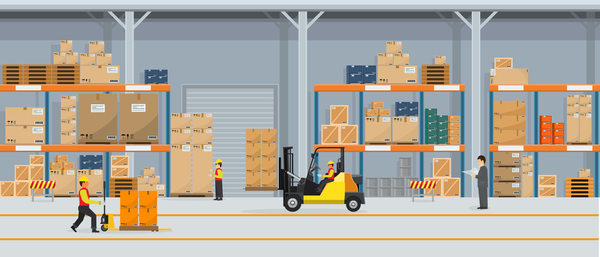With warehouse and logistics functions being critical to the success of most businesses, it’s perhaps not a surprise that organizations look to avoid needless warehouse mistakes that can impact the customer, drive cost or reduce efficiency.

So, what are these mistakes, why are they so common? How can effective warehouse functions avoid them?
In today’s article, we will be looking into some example warehouse mistakes, their impact, and what your business can do to mitigate.
We’ll be looking at:
- What are warehouse mistakes
- Common warehouse mistakes
- Warehouse & business model are misaligned.
- Manual Inventory Management
- Poor use of technology
- Poor data
- Poorly trained staff
- Excess inventory
- Poor quality inventory
- Not optimizing your layout
- Managing all stock the same way
- Failing to manage orphaned transactions
- Failing to audit inventory
- Assuming your customer needs won’t change.
- Poor labeling and signage
- Disorganized & Messy Warehouse
- Poor safety
- Disconnected from other functions
- How to avoid warehouse mistakes
What are warehouse mistakes?
Warehouse mistakes are issues that affect efficiency and effectiveness and result in ‘waste’ such as increased costs, impacts to the customer, and others that hinder the organization’s ability to meet its goals and objectives.
Mistakes could be simple, one-off events, or repeat offenders where due to a variety of issues go undetected and/or unresolved.
Root causes are typically one of three,
- People,
- Systems, or
- Process
Mistakes can be simple to remedy, i.e., introducing audits to validate stock levels or complex such as deploying warehouse management systems.
Despite the warehouse function’s critical importance, it remains an area fraught with challenges and one which many businesses fail to remedy or optimize.
Common warehouse mistakes
Now we’ve provided some context, let’s now look at some common warehouse mistakes
1) Warehouse & business model are misaligned.
The first mistake many businesses make is that they have not aligned their warehouse and business model. Depending on the business type (and its goals), there may be specific needs or exclusions to the way in which the warehouse should be established.
For example, consider a distributor vs. retail. Each business may have different requirements and goals, leading to two very different warehouse configurations.
Unfortunately, too many adopt the ‘one size fits all’ approach resulting in a warehouse that doesn’t meet the needs of the business.
2) Manual Inventory Management
Effective inventory management is crucial to the flow of your business. However, managing complex inventory and its associated processes requires the right tools to be effective. Alas, some businesses skip this part and attempt to manage their inventory on things like spreadsheets, or at worse, using manual paper-based systems. In 99% of cases, this is a recipe for an underperforming warehouse, often resulting in chaos.
3) Poor use of technology

Just as some try to deploy warehouse management without the right technology, others have it but fail to use it effectively. Having great tech is one thing, but you need it configured correctly and to train your staff effectively in its use. There are three common issues with warehouse technology & systems.
- Businesses don’t know how to use it and bypass it using alternatives (We see you Excel!)
- Businesses only know how to use a small part of it, missing many of its key features and potential benefits.
- The technology in use has been poorly selected and does not meet the requirements of the business.
4) Poor data
All too often, organizations have appropriate systems but little respect for the quality of the data within it. Management systems rely on effective data to be of use. Common data related issues include:
- Data entry errors that don’t get corrected
- People ‘bending the intended use of the software because the system it’s not aligned to need. Data entry fields not meant for a type of data are used as there’s no alternative.
- Data is not maintained; it gets old and outdated.
- Essential attributes are not captured, which hampers productivity.
The results from poor data can be significant. From inaccurate inventory lists, labeling issues, stock not being in the right locations through to disenfranchised staff.
Robust data is a critical enabler in driving a successful warehouse operation.
5) Poorly trained resources
A further resource that often gets underused is people. Far too many organizations fail to invest in skilled operators, failing to fully grasp what skills are required within a modern, complex warehouse.
Often, training is also, sadly, an afterthought. A business can have expensive software and tools, modern layouts, and effective processes, but if you have poorly trained staff who are unaware of their responsibilities or cannot execute them, you are going to face challenges.
6) Too much inventory
One of the most widely discussed issues with warehouse management is the problem of excess inventory.
Having too much stock can be due to a variety of reasons, eg:
- Poor planning.
- Failing to negotiate effective minimum order quantities.
- Old stock that has not been written off and has languished in the system
- …and many others.
Whatever the reason, it takes up valuable floor space in terms of storage, people to manage it, amongst other issues. Ultimately, excess inventory drives cost.
7) Poor quality inventory
Whilst not necessarily impacting the day-to-day storage or management, poor quality inventory can add a significant resource burden in managing returns, managing replacement inventory, managing extra processes in remedial action.
8) Not optimizing your layout.
Warehouse layouts require effective consideration from the outset. Having a clear plan around the layout, picking paths sizes of certain areas (arrivals, for example), and access can drive significant levels of productivity. Fail to get them right, and you are introducing waste into your system. These plans should be reviewed regularly to ensure they remain fit for purpose and aligned with business need.
9) Managing all stock the same way
All stock is different. For example, there are different demand patterns, different lead times, different ergonomics, different quality standards, different health & safety considerations. As a result, if you are treating all stock the same, then you’re storing up problems for later.
10) Failing to manage orphaned transactions

Without effective processes that manage picks from the cradle to the grave, warehouses can find themselves with stranded or incomplete transactions. For example
- Partly picked orders that are forgotten about,
- Items picked not despatched
- Items not picked
You must have an adequate management system that manages and reports on incomplete transactions, highlighting where there are issues to address.
11) Failing to audit inventory
Mistakes happen, and things go wrong. As a result, it’s important that you check your inventory for accuracy. Devising an audit plan where you review locations, labeling, quantities, etc., can help you avoid costly errors later. Audits allow you to find issues with your inventory before your customers do.
12) Assuming your customer needs won’t change.
It’s fair to say that change is a constant in most businesses. Failing to accept that and have regular review cycles where you assess your warehouse model for suitability can leave you with an outdated model that has inefficiency built-in.
13) Poor labeling and signage
Of course, you want your operators to find things quickly and easily. Where signage is inadequate locating stock can not only be challenging, but in some circumstances, it can result in stock being mislaid.
14) Disorganized & Messy Warehouse
In a busy warehouse, things can get disorganized pretty quickly. Keeping things tidy is often an afterthought, with delivery boxes, pallets, documentation, and equipment high on the list of offenders.
However, being disorganized can not only introduce inefficiency but can also raise safety issues.
15) Poor safety
This final point is perhaps the most important. Warehouses can be dangerous places with heavy goods and materials and potentially hazardous equipment. Failing to identify these hazards correctly can result in harm to your employees or visitors to the area.
16) Disconnected from other functions
A warehouse is not an island! It needs to be heavily integrated with other functions within the business. All too often, the warehouse function is the last one to be thought of when considering the impact of business decisions. In particular, failing to consider the warehouse within the purchasing cycle can result in one that cannot fully support the needs of the business.
How to avoid warehouse mistakes
As you can see from the above, there are some common themes when addressing warehouse issues.
So what can be done to avoid them?
Firstly it’s key to deal with things swiftly and pragmatically, constantly learning from experiences and driving improvement. Consider the following:
- Recognize that warehouse design is not fixed and can change – Establish a routine review for assessing the suitability of your warehouse design. Does it meet your needs? Don’t be afraid to change it if it’s grown stale.
- Focus on planning – Planning is perhaps the key driver for success. Be less reactive and try and get in front of what’s happening. A better plan will drive optimization and improved success.
- Be sensible about technology – from software such as warehouse management systems to automation technology, you can put a lot of tech to use in a warehouse. However, don’t just use it blindly; Be clear in how it will provide benefit, and it can be best configured to provide the best value. Then train your staff so they can use it effectively.
- Treat your team as a valuable resource. One of the key elements that can deliver value in your warehouse is its staff. Listen to their issues, invest in training, provide appropriate tools and involve them in planning.
- Embed continuous improvement – stating the obvious – learn from mistakes. Challenges and problems in a complex business are unavoidable; however, failing to learn so that issues don’t reoccur is not.
Summary
Warehouses are complex elements of a modern business. They can have a key impact on cost, efficiency, and effectiveness. Warehouse processes can significantly influence how a customer views the business.
It is inappropriate to think that a complex function that deals with 1000’s of products will be without mistakes.
However, many of these are common-place, and with some planning and appropriate consideration, many of these common issues can be avoided.
Have you experience in warehouse management? What issues have you seen? How have you dealt with mistakes? How have you eradicated some of these issues, perhaps you implemented continuous improvement?
As ever, we’d love your feedback; you can leave feedback in the comments section below or reach us on Twitter at @sanbustrain. We’d love to hear from you!
You can find our article on warehouse shipping mistakes here.
This article is part of our Supply Chain Guide.